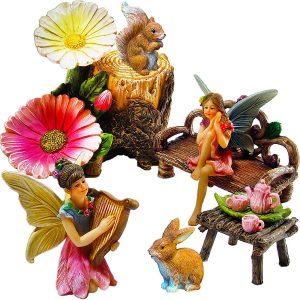*This post may contain affiliate links for which I earn commissions.*
Creating a fairy garden in your own backyard is a delightful way to add a touch of enchantment to your outdoor space.
Fairy gardens spark the imagination, inviting both young and old into a miniature world of whimsy and wonder.
With the right mix of plants, accessories, and a dash of creativity, you can transform any corner of your yard into a magical retreat.
From choosing a captivating theme to picking the perfect spot, the process itself is a fun and therapeutic experience.

Add some fairy houses, moss and pebble walkways and let your imagination take you back to when you were little and dreaming of visiting the fairies.
Doesn’t every little girl want to stay in a fairy house?
I know I do!
There are so many things you can make with a fairy garden and it doesn’t all have to be for little girls. Boys can have fun and make many different villages. They can make a smurf village, or a troll bridge let their imagination bloom.
You can even add tiny fairy lights to you fairy garden so it lights up at night.
Just think of all the fun the kids will have with this!
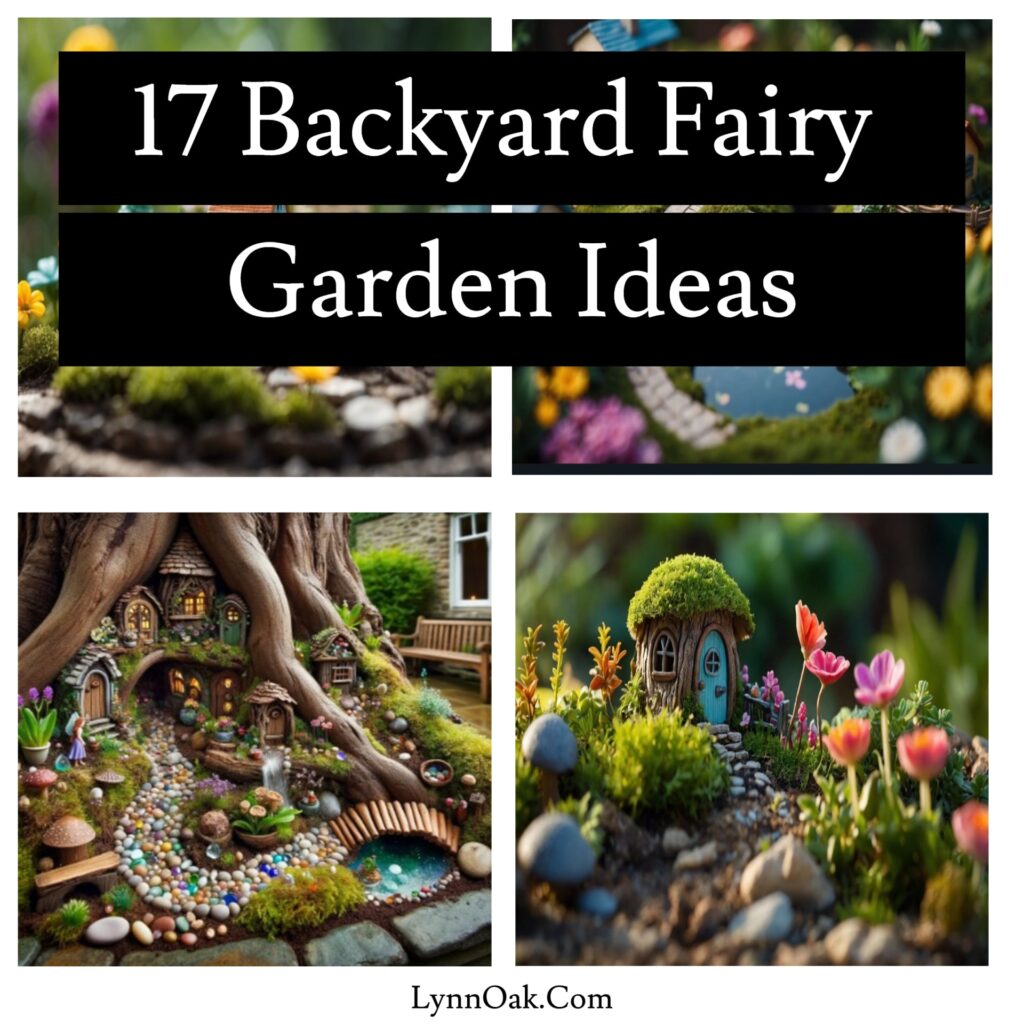
Fun Fairy Garden Ideas
Magical Fairy House For Fairy Garden
I love this enchanted fairy house! It will be perfect addition to fair garden. I can see myself laughing with the fairies on a warm summer’s day.
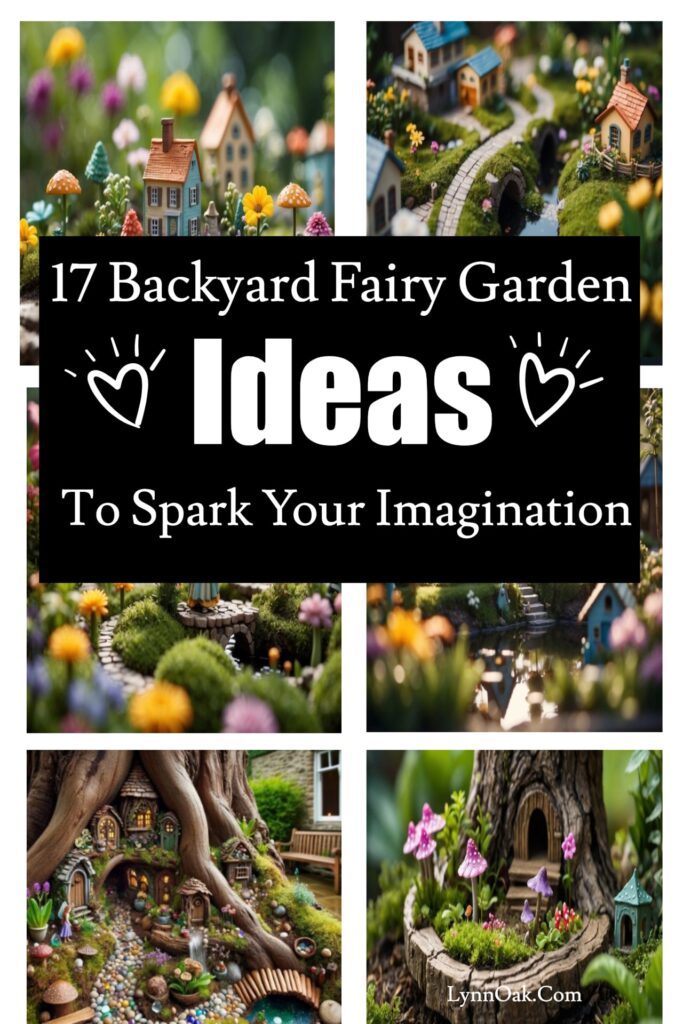
Backyard Fairy Garden Ideas For Kids
This set of fairies would go very nicely with the wagon above. They can have a little patio area that can be made up playful painsies would be nice. Oh, and tiny fairy lights would be so cute in the patio area.

Magical Dragon Backyard Fairy Garden Ideas
Now how about a little dragon in the miniature village? Don’t let him burn anything! Cute little guy, perfect pet for the fairies! I love that lady bug on his nose.
Cute Fairy Garden Sign Ideas
I believe in fairies!
How about you?
This little sign would be nice in the wooded area of the garden. Which can be made anywhere. I’ve seen them set up in old metal tubs filled with dirt, makes it easy to add to your deck or patio.
Any large container that you won’t mind as a decor piece that the kids can get to without any hassles. I’ve also seen where people just add a fairy garden to their flower bed.
Designate a part of your flower garden just for that. Or find an old wash pan from a thrift shop would do nicely.
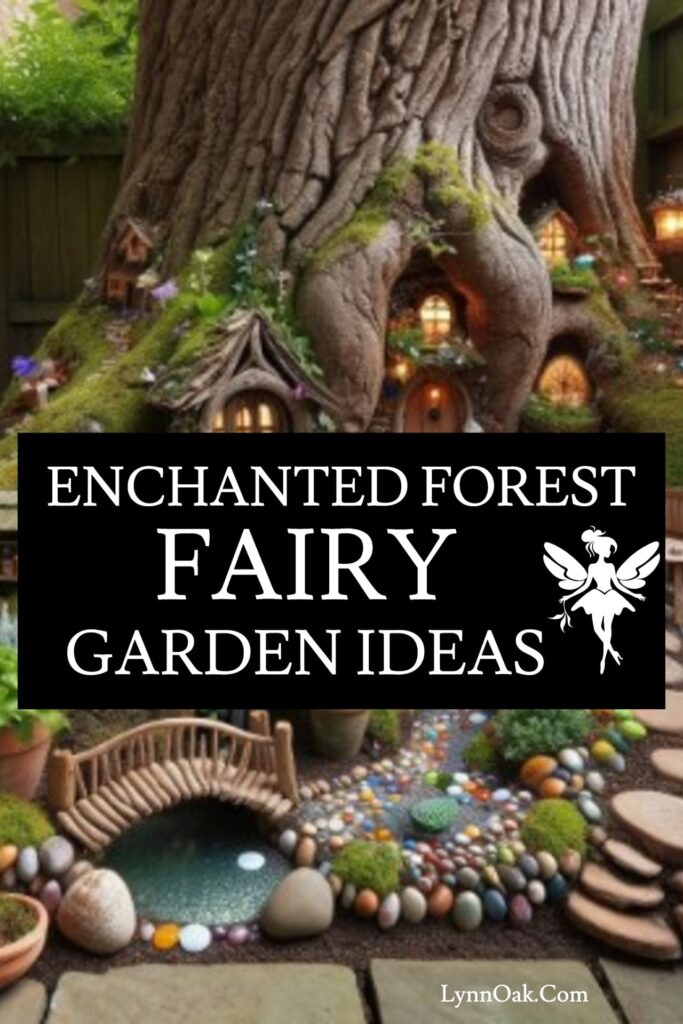
If you have a big tree in the backyard, you might want to create an enchanted forest around one side of the tree trunk. Adding miniature rustic doors and moss with pebbles, with whimsical walkways. Let your imagination flow and lose yourself in its magic. I bet even some real fairies will move in!
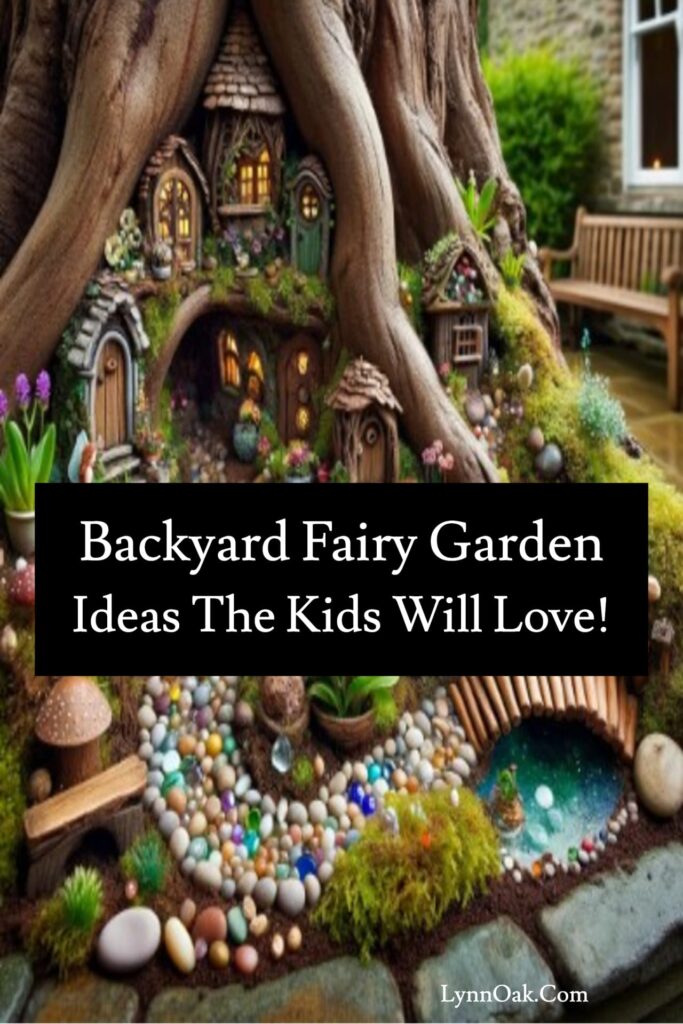
Backyard Fairy Garden Ideas
As you embark on your fairy garden adventure, consider the layout and the types of plants that will bring your vision to life.
The arrangement of pathways, seating, and diminutive structures will form the backbone of your design, while the selection of plants and flowers adds color and vitality.
To truly personalize your fairy sanctuary, handmade crafts and carefully chosen fairy-themed accessories can make all the difference, imbuing your garden with character and charm.
Key Takeaways
- Fairy gardens enhance outdoor spaces with creativity and whimsy.
- Personal touches and themed accessories enrich the garden’s narrative.
- Engaging in fairy gardening can be a joyful activity for people of all ages.
Choosing Your Fairy Garden Theme

When I create a fairy garden, I begin by deciding on a theme that makes the space shine with magic and wonder. Here are a few of my favorite themes to inspire you.
Enchanted Forest
For an Enchanted Forest theme, I incorporate elements that mimic a dense, mystical woodland. I focus on:
- Plants: Ferns and mosses to represent the lush forest floor.
- Accessories: Miniature trees and toadstools to create a forest vibe.
- Fairies: Winged fairy figurines peeking from behind leaves.
Whimsical Wonderland
The Whimsical Wonderland theme is all about playfulness and charm. Key features include:
- Color: I use bright flowers like marigolds and pansies for pops of color.
- Characters: Charming creatures such as tiny unicorns or dragons.
- Accents: Sparkling pebbles or swirling paths leading to miniature castles.
Rustic Retreat
With the Rustic Retreat theme, it’s about simplicity and natural beauty. I always remember to:
- Materials: Use wood and stone to keep things grounded and natural.
- Design: An emphasis on miniature cottages and twig furniture.
- Plants: Succulents and herbs bring a touch of greenery that’s easy to maintain.
Backyard Fairy Garden Ideas-Selecting the Perfect Location

When I choose a location for my fairy garden, I consider light exposure, visibility, and how it blends with the natural landscape.
Shady Nooks
My ideal shady spot is under a tree or beside a building. This provides protection for delicate plants that thrive in indirect light.
Plants I use here: Ferns, moss, and hostas.
Sunny Spaces
In sunny spaces, I ensure my fairy garden has plants that love the sun and can tolerate more heat.
Soil type: Well-drained sandy soil is best to prevent waterlogging.
Patio Edges
For patio edges, I select container plants that add charm without taking over space.
Container advice: Use pots with drainage holes to keep roots healthy.
Designing Your Fairy Garden Layout

Crafting a fairy garden layout involves thoughtful placement of miniature landscapes, winding pathways, and enchanting structures. It’s about creating a harmonious space that invites whimsy and charm.
Miniature Landscaping
In my fairy garden, I like to create a base of greenery with moss as a lush carpet and accent it with tiny plants like baby’s tears or miniature daisies for color.
Arranging small stones and pebbles can mimic cliffs and hills, giving my fairies varied terrain to explore.
Pathways and Bridges
I ensure that my fairy garden has meandering pathways made from pebbles or sliced wood, leading the eye through the garden.
For an intriguing touch, I add rustic bridges over dry river beds made of blue glass shards to represent water.
Fairy Houses and Structures
Building the fairy houses, I opt for natural materials like bark, twigs, and acorns to blend them into the landscape.
Incorporating delicate arbors or tiny gazebos crafted from bent wire wrapped with ivy lends an air of magic to my fairy garden, inviting fairies to take residence.
Picking Plants and Flowers

I always find it crucial to carefully choose plants and flowers that will thrive in my fairy garden with minimal upkeep.
I consider both the aesthetic appeal and the growth habits to ensure a charming and lush environment.
Mosses and Ground Covers
I use mosses to create enchanting green carpets that add texture and a sense of age to my fairy garden. Here are my go-to options:
- Irish Moss: Its soft, bright green hue provides a magical underfoot feel.
- Scotch Moss: Its golden-green color stands out, offering a delicate, cushioned ground cover.
For a bit of variety, I also include other ground covers:
- Creeping Thyme: Tiny purple flowers bring a sprinkle of color, and it handles foot traffic well.
- Baby’s Tears: The small, rounded leaves form dense mats that work perfectly around fairy structures.
Colorful Blooms
I select colorful blooms to add vibrancy and provide a miniature landscape for my fairy visitors:
- Pansies: These come in a multitude of colors and patterns and are easy to maintain.
- Lobelia: The rich blues and purples of lobelia flowers contrast beautifully against green moss.
- Dianthus: With their miniature size, they resemble small trees for fairies and come in pink, red, or white.
| Bloom Type | Color Options | Maintenance Level |
|---|---|---|
| Pansies | Multiple | Low |
| Lobelia | Blues/Purples | Moderate |
| Dianthus | Pink/Red/White | Moderate |
Dwarf Shrubs and Trees
I choose dwarf shrubs and trees that stay small, requiring less pruning and fitting perfectly into the tiny world:
- Dwarf Juniper: It provides year-round greenery and has a wonderful, woodsy scent.
- Miniature Roses: Not only do they stay compact, but they also offer a traditional fairy tale feel.
- Boxwood Shrubs: These can be trimmed into shapes to create hedges or mazes for an added fun element.
Incorporating Fairy Garden Accessories

Adding fairy garden accessories is a delightful way to bring charm and personality to your miniature garden. These small details can make a whimsical world feel alive and magical.
Hand-Painted Fairy Figurines
- Variety: I always include a range of hand-painted fairies to add character. You can find figurines in various poses—from sitting to flying—each adding a unique touch.
- Placement: Strategically placing these figurines around the garden makes it look like they’re interacting with the environment.
Sparkling Pebbles and Gems
- Paths: Use glittering pebbles to create pathways that lead to fantastic little fairy houses.
- Highlights: Scattering gems around focal points catches the eye and adds a magical sparkle to the garden, especially under the moonlight.
Tiny Furniture and Décor
- Seating: I make sure there are tiny benches and chairs for fairies to rest. It’s all about creating a scene that visitors can imagine coming to life.
- Details: Adding miniature décor like a tiny mailbox, garden tools, or a fairy-sized hammock can invite a closer look and bring delight to onlookers.
DIY Fairy Garden Crafts

In my pursuit of a charming backyard space, I’ve discovered that crafting your own fairy garden pieces adds a personal and enchanting touch. Here are some projects I’ve found delightful and fitting.
Homemade Fairy Houses
I love making fairy houses using natural materials such as bark, twigs, and acorns.
I typically start by gluing the bark to small containers to form the walls and roofs. Then, I decorate the exteriors with moss and pebbles, creating a rustic abode for the fairy folk. Here’s a quick step list to get started:
- Select a container (old jars or pots work well).
- Glue bark around the container to form walls.
- Use twigs to craft a tiny pitched roof.
- Adorn with natural elements like moss and pebbles for aesthetics.
Creative Planters
For my fairy garden, planters are more than just pots; they’re part of the landscape.
I transform teacups, broken pots, and even old shoes into planters, infusing the scene with creativity and a sense of wonder. Following these steps should make it easy:
- Choose an unconventional item (like a teacup or shoe).
- Fill with potting soil and your choice of small plants or succulents.
- Place your planter within the fairy garden setup to add depth and character.
Nature-Inspired Ornaments
Adding ornaments that mimic the whimsy of nature is essential. I use polymer clay to create miniature mushrooms, birds, and butterflies, then paint them in vibrant colors before placing them around my garden. They add a pop of color and life to the miniature world I’m creating.
A simple ornament-making process could be:
- Sculpt tiny animals or mushrooms from polymer clay.
- Bake them according to clay package instructions.
- Once cool, paint the sculptures to resemble real-life counterparts.
- Place the ornaments around your garden to create a magical scenery.
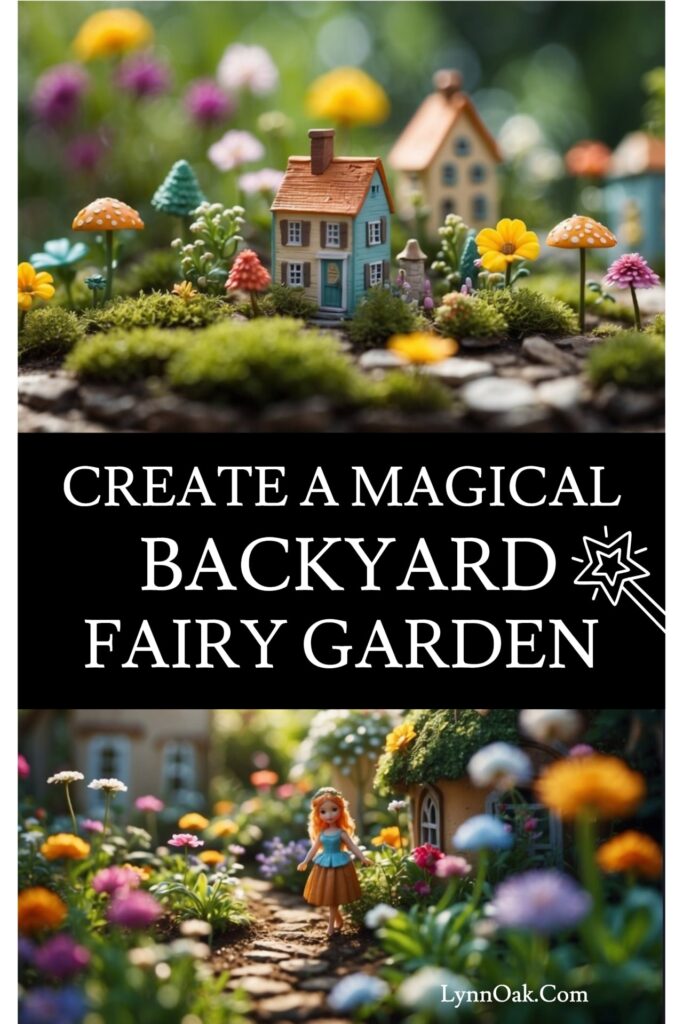
Maintenance Tips for Your Fairy Garden
Maintaining a fairy garden requires attention to detail and a touch of gentleness to keep the magic alive. Here, I’ll share precise care routines to help you nurture your mini garden.
Watering Your Mini Garden
- Frequency: I water my mini plants when the topsoil feels dry to the touch.
- Amount: Just enough to moisten the soil without causing water to stand.
Pruning and Weeding
- Regular Check: I examine my fairy garden weekly to remove dead leaves.
- Weed Control: Weeds are plucked out gently to avoid disturbing the delicate plants and accessories.
Seasonal Updates
- Spring and Summer: I add blooming mini plants for color.
- Fall and Winter: I incorporate evergreens to maintain a lush look throughout colder months.
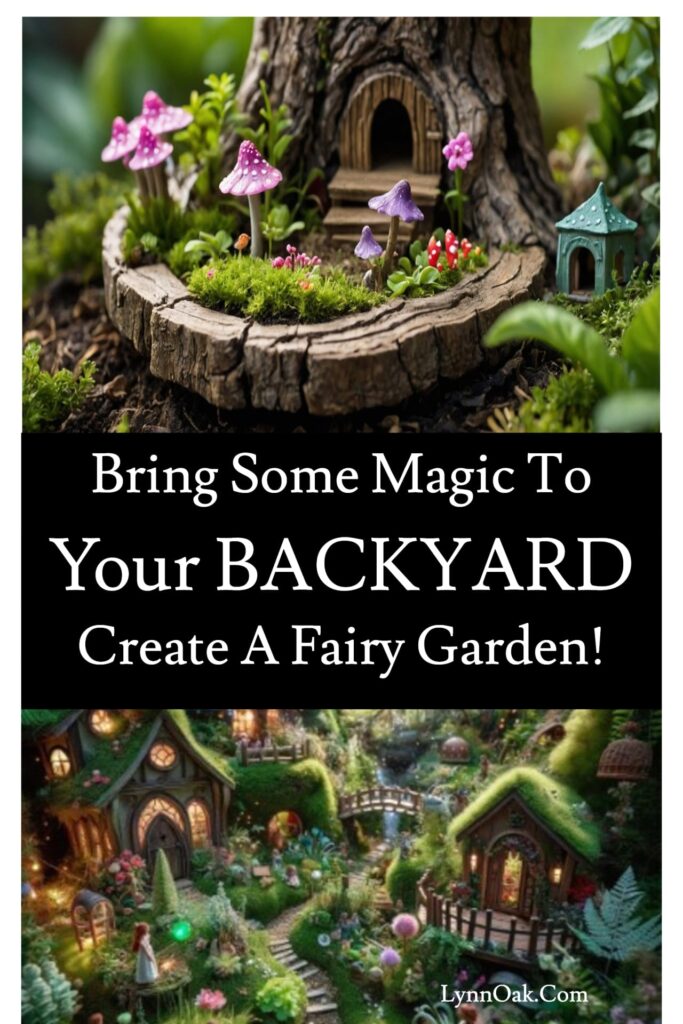
Engaging Kids in Fairy Gardening
Creating a fairy garden is a wonderful way to spark imagination and foster a love of nature in children. It’s an interactive activity that blends creativity with outdoor play.
Fun Gardening Activities
I find it essential to include kids in the planning and building stages of a fairy garden. Here are some hands-on activities to get them involved:
- Selecting a Theme: Have the kids pick a theme for the garden. This could be anything from a woodland realm to a beach oasis.
- Planting: Guide them in planting miniature plants and flowers, perfect for a fairy setting.
- Crafting Accessories: Encourage creating tiny houses, furniture, and pathways using natural materials like sticks, stones, and leaves.
Learning about Plants and Nature
Engaging with a fairy garden is more than play—it’s educational. Here’s what kids can learn:
- Plant Growth: They’ll observe how plants need water, sun, and care to grow.
- Ecosystems: Children discover the roles of insects and other wildlife within the garden setting.
Storytelling and Play
Storytelling is integral to the spirit of fairy gardening. Through this, children can:
- Develop Narratives: They invent stories about the fairy inhabitants and their daily adventures.
- Role Play: Kids often enjoy playing the parts of fairies or other magical creatures. This exercise helps them exercise their imaginations and verbal skills.
Conclusion
I hope you enjoyed my backyard fairy garden ideas article. I’m sure you’re full of creating ideas on how to create a magical wonderland in your own backyard this summer.
Have fun and be magical!
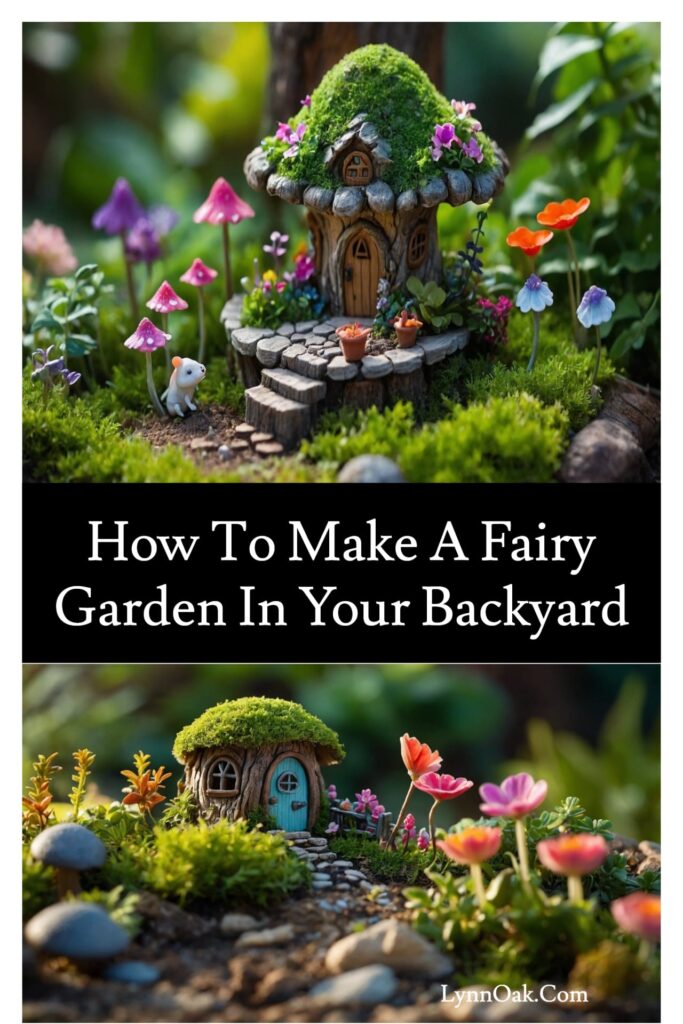
YOU MIGHT ALSO LIKE TO READ:
Best Children’s Bookshelf and Toy Storage
Dinosaur Themed Birthday Party
Harry Potter Bathroom Accessories



